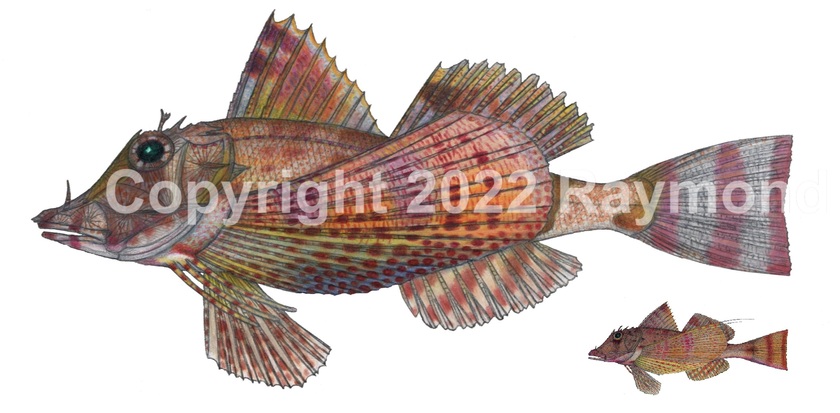
Common Name
Bandtail Searobin
Year Described
Jordan & Swain, 1885
Identification
Dorsal Fin: X, 12
Anal Fin: 10
Pectoral Fin: 13-14
Body relatively stout but elongate and slightly compressed . Head is large, bony, and heavily sculptured with pronounced ridges and spines. Head relatively deep with a distinct indent in front of eyes. Duck-billed snout is short. Mouth is subterminal and moderate in size, containing bands of villiform teeth on the jaws, vomer, and palatines. Jaw reaches to front of eye. Nostrils with small spines. Prominent cirri on nostrils and in front of eyes. Preopercle and opercle usually bear strong spines. Preopercular spine does not reach past edge of opercle. Large, fan-like pectoral fins with strongly branched rays, with the lower three rays free, thickened, and separate from the fin membrane. Pectoral fin viewed from above broadly rounded with a blunter anterior margin. Pectorals when folded reach rear edge of anal fin base. Two dorsal fins: one spiny and one soft rays. First dorsal spine longest. Anal fin opposite soft dorsal fin. Caudal fin is truncate. Pelvic fin underneath pectoral fin on belly. Body covered in small ctenoid scales with the exception of the naked ventral surface. Nape scaled. Opercular membrane above spine partially scaled. Lateral line is continuous.
Color
Color highly variable. Body and head heavily mottled and spotted with various shades of brown and red over tan and white. Larger blotches can form irregular oblique bands under the dorsal fins. Head with a darker eye-band and an adjacent white band behind the eyes. Red-brown and white alternating bands usually cross snout and jaw. Caudal peduncle with a prominent solid white band bordered by solid red-brown bands. Dorsal fins heavily mottled with brown with spots along spines/rays. Sometimes with indistinct dark spots on fin membranes and whitish frosting on the anterior part of dorsal fins. Pectoral fins shades of brown with a few concentric bands of a darker brown and heavy dark spotting. Pectoral free rays banded red. Anal and pelvic fins pale with red-brown spotting. Caudal fin whitish with three distinctive reddish bands. Juveniles with larger and larger spots on the pectoral fins, with the lower margin becoming bright blue in smaller fish.
Size
Maximum size to 20cm SL.
Habitat
Soft bottoms from 8-170m (usually 20-70m).
Range
North Carolina to N. Brazil, including the Caribbean islands. The only searobin likely to be found around the Caribbean islands but much rarer there.
References
Richards, W. J. & G. C. Miller. 2003. Triglidae (pp. 1266-1277). In: Carpenter, K. E. (ed.) 2003. The living marine resources of the Western Central Atlantic. Volume 2: Bony fishes part 1 (Acipenseridae to Grammatidae). FAO species identification guide for fishery purposes and American Society of Ichthyologist and Herpetologists Special Publication No. 5. FAO, Rome. v. 2: i-vii + 602-1373.
Victor, B.C. & L. Ianniello. 2020. Prionotus murielae Mowbray, 1928 is the juvenile of the Bandtail Searobin Prionotus ophryas (Teleostei: Scorpaeniformes: Triglidae). Journal of the Ocean Science Foundation, 35, 76-85.
Other Notes
Prionotus murielae (inset illustration) is a synonym. It is based on a single juvenile specimen of P. ophryas with filamentous upper pectoral rays. The only Prionotus searobin in the area with cirri over the eyes.